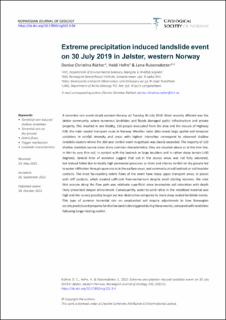| dc.contributor.author | Rüther, Denise Christina | |
| dc.contributor.author | Haugland, Heidi Hefre | |
| dc.contributor.author | Rubensdotter, Brita Lena Eleonor Fredin | |
| dc.date.accessioned | 2023-02-16T07:38:39Z | |
| dc.date.available | 2023-02-16T07:38:39Z | |
| dc.date.created | 2023-01-26T13:23:34Z | |
| dc.date.issued | 2022 | |
| dc.identifier.citation | Norwegian Journal of Geology. 2022, 102 . | en_US |
| dc.identifier.issn | 2387-5844 | |
| dc.identifier.uri | https://hdl.handle.net/11250/3051270 | |
| dc.description.abstract | A torrential rain event struck western Norway on Tuesday 30 July 2019. Most severely affected was the Jølster community, where numerous landslides and floods damaged public infrastructure and private property. This resulted in one fatality, 150 people evacuated from the area and the closure of Highway E39, the main coastal transport route in Norway. Weather radar data reveal large spatial and temporal variations in rainfall intensity and areas with highest intensities correspond to observed shallow landslide clusters where the 200-year rainfall event magnitude was clearly exceeded. The majority of 120 shallow landslide source areas share common characteristics: they are situated above or at the tree line, in thin to very thin soil, in contact with the bedrock or large boulders and in rather steep terrain (>30 degrees). Several lines of evidence suggest that soil in the source areas was not fully saturated, but instead failed due to locally high porewater pressures as short and intense rainfall on dry ground led to water infiltration through open cracks in the surface cover, and commonly at soil-bedrock or soil-boulder contacts. The most far-reaching debris flows of the event have steep upper transport areas, in places with cliff sections, which created sufficient flow-momentum despite small starting volumes. We note that erosion along the flow path was relatively superficial since incomplete soil saturation with depth likely prevented deeper entrainment. Consequently, water-to-solid ratios in the mobilised material was high and the runout possibly longer but less destructive compared to more deep-seated landslide events. This type of summer torrential rain on unsaturated soil require adjustments to how Norwegian society predicts and prepares for shallow landslides triggered during these events, compared with landslides following longer-lasting rainfall. | en_US |
| dc.language.iso | eng | en_US |
| dc.publisher | Norsk Geologisk Forening | en_US |
| dc.rights | Navngivelse 4.0 Internasjonal | * |
| dc.rights.uri | http://creativecommons.org/licenses/by/4.0/deed.no | * |
| dc.title | Extreme precipitation induced landslide event on 30 July 2019 in Jølster, western Norway | en_US |
| dc.type | Peer reviewed | en_US |
| dc.type | Journal article | en_US |
| dc.description.version | publishedVersion | en_US |
| dc.rights.holder | © Copyright the authors | en_US |
| dc.source.pagenumber | 26 | en_US |
| dc.source.volume | 102 | en_US |
| dc.source.journal | Norwegian Journal of Geology | en_US |
| dc.identifier.doi | 10.17850/njg102-3-4 | |
| dc.identifier.cristin | 2115687 | |
| cristin.ispublished | true | |
| cristin.fulltext | original | |
| cristin.qualitycode | 1 | |

